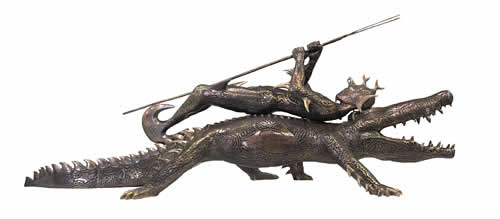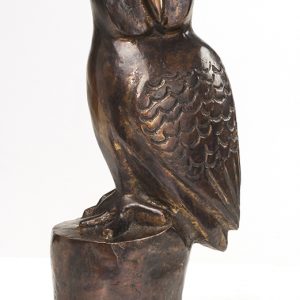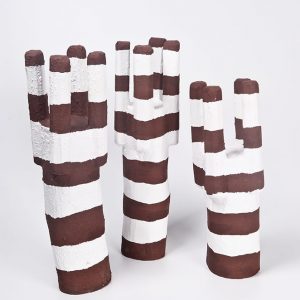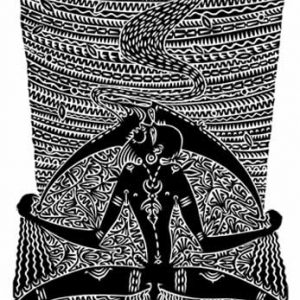Description
Ubirikubiri is one of many stories and dances adopted by the Torres Strait Islanders from their Papua New Guinean neighbours.
The story is told on Boigu, Mabuiag, Mer and the artist’s island of Badu. The artist first heard the story from the noted cultural authority and linguist, Ephraim Bani.
Badu Island elder, Issac Charlie, who first witnessed the performance of the Ubirikubiri dance on Badu in 1926, was also consulted prior to the creation of the sculpture.
The dance was performed by the crocodile clans on Badu and the other islands as a means of maintaining tradition and the spirituality of the people belonging to this and other totems. It was also a means of strengthening and perpetuating the crocodile spirit, Ubirikubiri
The 1926 performance took place at Argan Village which is located on the Awailau Kasa (River). The mask used in the dance was made of turtle shell (Karral) by the artist’s grandfather, Jomen Tamwoy and Mr. Baira. This mask was kept at Motau but no longer exists. Badu Island elder, Tuisofoa Nomoa, recalls seeing the mask and says that its loss was a consequence of the Pearling Industry that was booming in the late 1920s. Many of the Islanders were at sea for months at a time which meant that a lot of the ceremonies and dances were lost along with the material items associated with them. Ubirikubiri was one of the dances that survived and was first performed again in 1985 on Badu. This performance was witnessed by the artist.
Renowned Badu Island choreographer and dance mask creator, James Eseli has produced a number of crocodile masks that have been used in more recent Ubirikubiri performances. His masks can be seen in the collections of the National Gallery of Australia and National Museum of Australia.
The only Ubirikubiri dance mask from the last century known to exist is housed in the Cambridge University Museum of Archaeology and Anthropology. This turtle shell mask was collected by Alfred Cort Haddon who led a team of researchers from the University to the Torres Strait in 1898 to document and collect cultural material. This mask can be seen in the film ‘Cracks in the Mask’ which is about a quest by the wise and knowledgeable Torres Strait Islander, Ephraim Bani, to reclaim his people’s cultural artefacts from the great museums of Europe where his heritage lies.
Ubirikubiri is said to have travelled to several of the Torres Strait islands from its habitat in Papua New Guinea and specifically to the Awailau Kasa on Badu.
This is a legend that originated on the Mai Kasa, the river that runs into the Torres Strait from the Western coast of Papua New Guinea.
Following the death of his wife a man decided to give his daughter a pet to help console her and keep her company. He brought her a puppy but she didn’t like it. He then brought her a piglet but she didn’t like that either. One day when he was out spearing fish on the beach he came across a baby crocodile which he caught and took home to show his daughter.
She really liked it and named the crocodile Ubirikubiri. Her father made a pen for the crocodile. As it grew he kept enlarging the pen.
After it had become fully grown the father went to visit friends in another village and neglected to feed Ubirikubiri the entire time he was away. When he returned Ubirikubiri was very hungry and very annoyed having been left without food for such a long time.
As the father went to feed Ubirikubiri some fish he grabbed him and killed him then broke out of the pen placing the father on his back and heading off to the Mai Kasa.
The daughter, who had not been at home when Ubirikubiri seized her father, saw the broken pen and evidence of a skirmish. She followed Ubirikubiri’s tracks to the river calling out to the crocodile to tell her about her father.
At Ziba Ziba (that time of day when the sun has almost set) Ubirikubiri appeared on the river bank with her father on his back. She pleaded with the crocodile to give up her father but shaking his huge body he refused and headed back in to the river.
There is a moral to this story that instructs us that if animals are taken from their natural environment they must be looked after and treated and cared for properly.





